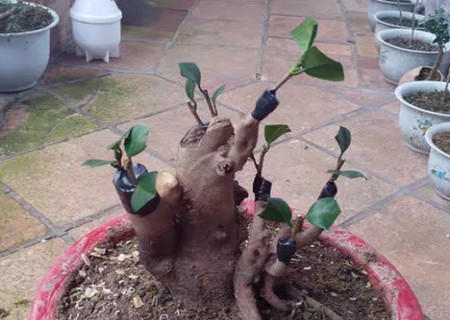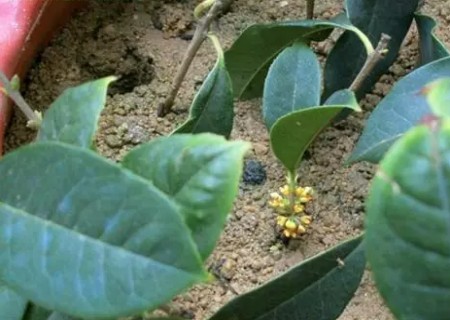Grafting time and method of Osmanthus fragrans
Sweet-scented osmanthus can be propagated by sowing, cutting, grafting, striping and other methods, but potted sweet-scented osmanthus often uses the method of grafting to breed young plants, and the grafting method can be divided into two methods: abdominal grafting and relying on grafting. For tree species such as sweet-scented osmanthus, if it is planted in pots, it is also feasible by means of sowing, but it is difficult to achieve the desired growth effect in terms of growth and propagation methods. So generally adopt the method of grafting to reproduce.

However, the use of grafting methods can not be carried out at any time, so when will potted sweet-scented osmanthus be grafted? What is the method of grafting? Today, the editor will share with you the grafting time and method of sweet-scented osmanthus.
1. Grafting time
For individual users, if sweet-scented osmanthus is planted in pots, it is more suitable to use grafting to achieve reproduction. The suitable time for grafting is from March to April in spring every year. Therefore, if we want to graft sweet-scented osmanthus, we have to choose accurately on the time node.
2. Grafting method
As the editor has said above, the grafting of sweet-scented osmanthus can be done in two ways: abdominal grafting and leaning grafting. Ventral grafting is mainly to properly trim the rootstock before grafting, while grafting is mainly to let the rootstock feed in the flowerpot before grafting. If the connection is adopted, it can also be carried out in June-July of each summer.
1. First, select the sweet-scented osmanthus tree in the pot to make rootstocks, and then cut the sweet-scented osmanthus tree in an appropriate position to ensure that the mouth is smooth. At the same time, use the tool to dig a U-shaped groove at the cut on the rootstock to insert the scion, the length is about 2.5 cm, the width is almost the same as the size of the scion, and the depth is half that of the scion.
2. Make a good scion according to the grafting. It is generally necessary to retain 3 buds and 2 and a half leaves on the scion; the lower end of the scion is cut into a circular arc at a 45-degree angle; peel off half of the lower part of the scion.
3. Insert the prepared scion into the U-shaped groove on the rootstock, so that the cuttings should be in full contact with the U-shaped groove, which can ensure that the scion is properly embedded in the U-shaped groove. Therefore, when making U-shaped grooves and scions, we must measure the size to avoid inserting the scions into U-shaped grooves and leaving large gaps that affect the survival of grafting.
4. You can cultivate different numbers of grafted seedlings according to your own needs for sweet-scented osmanthus pots or bonsai, but the number does not lie in many, but in essence, everything is based on the beauty of potted plants or bonsai as a reference.
5. After inserting the scion, we also need to wrap insulating tape on the grafting site to stabilize it. At the same time, it can also make the scion contact with the rootstock more closely and improve the survival rate to a certain extent.
6. If the temperature of grafting is relatively low, we can also cover all the grafted parts with transparent plastic bags, which on the one hand can reduce water evaporation and achieve the purpose of moisturizing, on the other hand, it can also play a role in heat preservation and cold protection.
This is the growth of twigs after successful grafting, and it is still very good on the whole. We can see that this plant has been properly topped and sprouted on each new shoot, which is mainly to promote its germination of more lateral branches and make the plant appear more "full-winged" in the later stage.
Time: 2019-06-06 Click:
- Prev

The fastest rooting method of Osmanthus fragrans cuttings
Sweet-scented osmanthus as one of the top ten traditional famous flowers in China, the fragrance of the flowers is refreshing, and the potted plants are more ornamental, so they are deeply loved by the majority of potted friends. And there are many propagation methods of sweet-scented osmanthus, usually sowing, cutting, grafting, striping and so on, but by contrast, cutting seems to be more simple and straightforward. Adopt different methods of reproduction
- Next

How to water the sparrow plum bonsai
Sparrow plum has peculiar root system, simple tree shape, many small buds and high ornamental value, so it is a good material for making bonsai. Compared with many tree species, Finch plum is relatively drought-tolerant, but it also likes to be wet, but it is afraid of being flooded, so usually watering needs to be carried out in accordance with certain rules. that
Related
- Fuxing push coffee new agricultural production and marketing class: lack of small-scale processing plants
- Jujube rice field leisure farm deep ploughing Yilan for five years to create a space for organic food and play
- Nongyu Farm-A trial of organic papaya for brave women with advanced technology
- Four points for attention in the prevention and control of diseases and insect pests of edible fungi
- How to add nutrient solution to Edible Fungi
- Is there any good way to control edible fungus mites?
- Open Inoculation Technology of Edible Fungi
- Is there any clever way to use fertilizer for edible fungus in winter?
- What agents are used to kill the pathogens of edible fungi in the mushroom shed?
- Rapid drying of Edible Fungi

